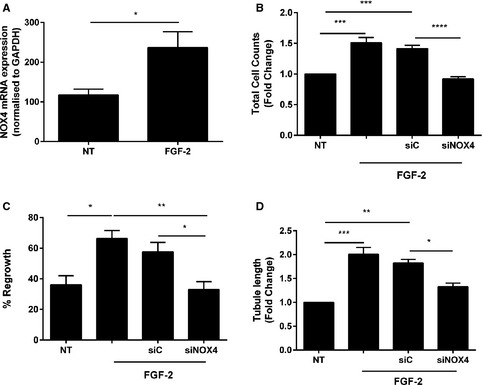Figure 8.

FGF‐2‐inducible proliferation, migration, and tubule formation involves NOX4. A, FGF‐2 increases NOX4 mRNA expression in ECs. HMEC‐1 cells were serum starved followed by 50 ng/mL FGF‐2 for 24 hours prior to RNA extraction and real‐time PCR. siNOX4 blocks FGF‐2‐inducible (B) proliferation and (C) migration. Growth‐quiescent HMEC‐1 cells were transfected with 200 nmol/L AllStar control (siC) and siNOX4 siRNAs for 3 to 6 hours prior to the addition of FGF‐2 (50 ng/mL). Cells counts were measured 72 hours later and migration assessed 24 hours later. D, siNOX4 blocks FGF‐2‐inducible tubule formation. Growth‐quiescent HMEC‐1 cells were transfected with siC or siNOX4 (200 nmol/L) overnight. Cells were then seeded in 100 μL of growth factor reduced Matrigel and treated with 50 ng/mL FGF‐2. Tubule formation was photographed and quantified 3 hours later. Data represent the combined results of at least 3 independent experiments. Results are expressed as mean±SEM; 1‐way ANOVA with Bonferroni comparison; *P<0.05, **P<0.01, ***P<0.001, and ****P<0.0001. ECs indicates endothelial cells; FGF‐2, fibroblast growth factor‐2; HMEC‐1, human microvascular endothelial cell‐1; NOX4, NADPH oxidase 4; NT, no treatment; PCR, polymerase chain reaction.
